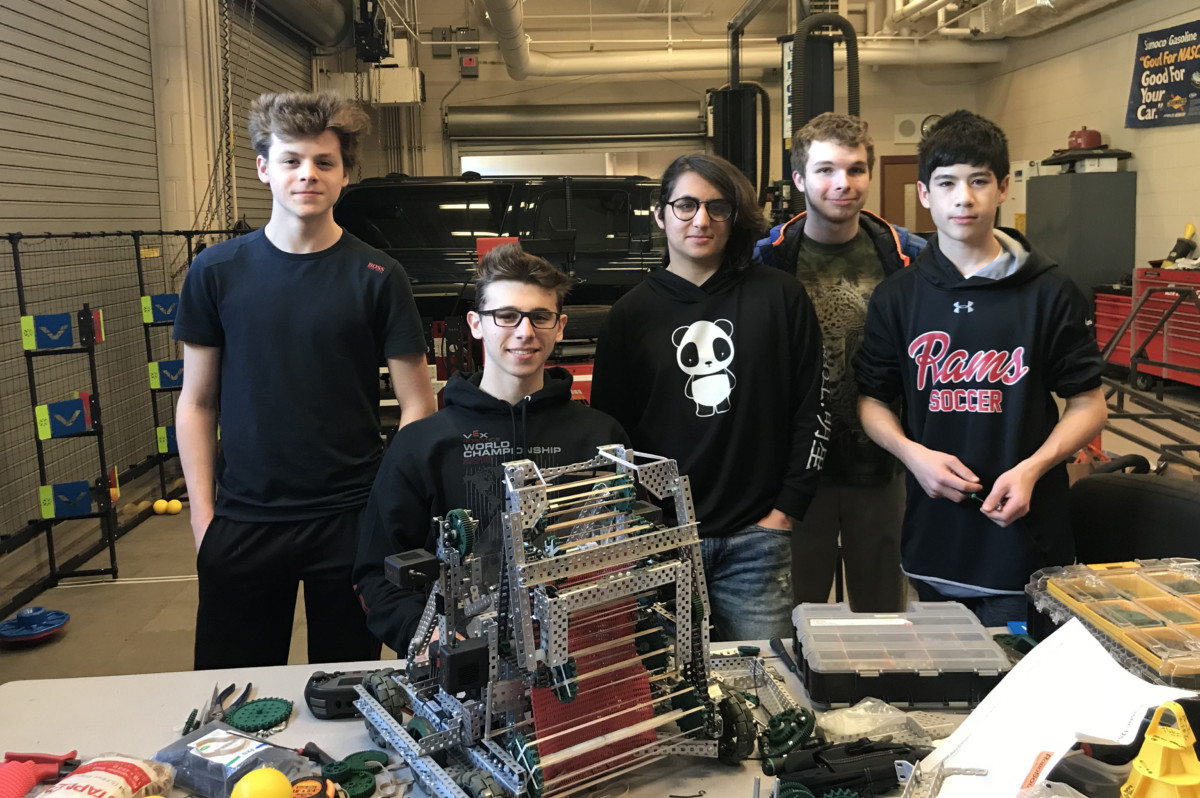Olivia Flaherty-Lovy, Editor-in-Chief
On April 24th, the top 7% of high school-designed robots in the world will be assembled in Kentucky for the world finals of VEX Robotics. For the second year in a row, included in the 900 teams representing over 20 countries will be the NCHS VEX Robotics team, 162A- RamTech, of senior Captain Ben Levin, senior Will Robertson, junior Katelyn McCall and sophomore Mark Levin.
Qualifying for World Finals is no easy task, but the NCHS team dominated the competition throughout the year. This year, they competed at all 8 of the Connecticut competitions and finished their run strong by winning the Southern New England VEX Robotics High School Regional tournament overall on March 17th in Worcester, Massachusetts.
The team maintained a perfect record over the two-day event, finishing undefeated in the qualifying rounds 10-0 and then proceeding to win the elimination rounds 4-0. “It’s exciting but it also puts a target on your back,” said club advisor Mr. James Zambarano.
The competition itself is highly structured and very technical. Each team is randomly aligned with another team and their robot in an alliance, either the red or blue alliance, so that a total of 4 robots are playing on the field at once. The field is a 12×12 arena of plexiglass and foam complete with challenges that the robots must complete to earn points.
This year, the game is called “Turning Point.” For 1 point each, the robots can fling balls at flags, for 1 point each, the robots can flip plastic caps so that they display the color of their alliance, and for 2 points each the robots can move the caps onto metal poles that line the arena. In addition, the robots can climb the lower level of a podium in the middle of the field for 3 points or the higher level of the podium for 6 points.
An important aspect of competitions that the team has been focusing on this year is defensive play, where the robots attempt to block the other robots from completing the challenges and earning points. “Once you’ve scored points you want to keep them, so you try to block the other robots,” said Mr. Zambarano. “There are a lot of rules and regulations around it because it’s so important.”

After a 15 second autonomous period where the robot does whatever it has been programmed to do to gain as many points as possible, the team competes in a one minute and forty-five second driver-controlled period. Sophomore Mark Levin, who joined the robotics club as a freshman, is the driver for the NCHS team. “During the event the team stands next to me advising me on things around the field as I figure out the best strategy at each moment, like whether I should shoot the balls or flip the caps or defend,” Mark said. “It’s very technical, and I have to practice to make sure I can control the robot to the best of my ability.”
Mark isn’t the only Levin brother making a difference on the team, though. Senior Ben Levin became involved with the high school Vex Robotics team in 8th grade after sharing his ideas for a design with members of the team, who then invited him to join the club. Now, as captain of the team, he has been able to see the club improve over time. “The most rewarding part is seeing the team progress and succeed in more ways than it has in previous years,” he said. “Last year our goal was just to make it to worlds, where we were 3 and 7, but this year we want to see if we can be 10 and 0.”
Though the team started competing in October, the preparation began long before that. “On the last day of Worlds, they release the challenge for next year, so we start designing in May,” said Mr. Zambarano. “The team starts building prototypes over the summer, starting with the base of the robot and then moving on to specifics.”
From unreliable vision sensors to rubber bands that snapped the day of a competition to a flywheel that was eventually replaced by a double-armed catapult, the team has encountered many challenges throughout the year but has been able to overcome them through teamwork and collaboration. “What’s great about this team is that they’re all individuals and all bring something different,” said Mr. Zambarano. “I didn’t think it would ever get better than last year but the chemistry is as strong as it’s ever been.”




